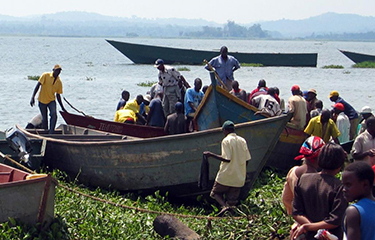A new project is underway in East Africa that could reverse declines in Nile perch and tilapia in Lake Victoria and revamp the fishery’s aquaculture production systems, opening opportunity for access to bigger regional and international seafood markets.
The European Union-financed East African Community (EAC) project for promoting aquaculture in the Lake Victoria Basin, dubbed TRUE-FISH, entails supporting the growth of regional and international commercial fish-farming networks, training skilled aquaculture producers and workers, and promoting sustainability and biosecurity in Lake Victoria’s aquaculture production systems shared by Kenya, Uganda, and Tanzania. EAC is an intergovernmental organization composed of six countries in the African Great Lakes region in eastern Africa: Burundi, Kenya, Rwanda, South Sudan, Tanzania, and Uganda.
The project recently received a major boost when the Malaysia-based international nonprofit research organization WorldFish signed a research partnership with the Lake Victoria Fishing Organization (LVFO) focusing on increasing aquaculture production in Lake Victoria, the world’s second-largest freshwater lake. As an organization of the EAC, LVFO has mandates to harmonize, develop, and adopt conservation and management measures for the sustainable fisheries on Lake Victoria.
In a statement, Worldfish said it will technically assist LVFO “in strengthening aquatic animal health conditions, fish breeding, and the zoning of Lake Victoria for the protection of biodiversity.”
With support from WorldFish, LVFO will identify and manage constraints and sustainability risks “for the development of competitive and sustainable commercial aquaculture in the Lake Victoria region,” said Mike Phillips, the director of aquaculture and fisheries science for the CGIAR research program on fish agri-food systems at WorldFish.
The TRUE-FISH project “will contribute to the development of competitive, gender equitable and sustainable commercial aquaculture in order to support economic development and sustainable management of natural resources in the Lake Victoria basin," according to Worldfish.
Financing of the project was approved by the European Union, under the 11th European Development Fund, approved in the first quarter of 2018. The E.U. had previously allocated EUR 10.1 million (USD 12.3 million) for the project.
Over the last decade, Lake Victoria has experienced declining numbers in commercial fish stocks “due to overfishing, invasive species, pollution, and changing climatic conditions,” according to WorldFish.
“The catch and biomass of commercial species in the lake, in particular Nile perch and Nile tilapia, have declined, contributing to reductions in per-capita fish consumption in the region,” LVFO said.
LVFO will use the findings of the research to advise EAC member-countries on embracing and implementing policies and regulations that support sustainable and bio-security aquaculture production systems, at both the national and regional levels.
Currently, the EAC region’s total haul from wild-catch fisheries is slightly more than 800,000 metric tons (MT), with an additional 70,000 MT from aquaculture, which combined contribute an estimated 4 percent to the region’s gross domestic product, according to the E.U.
A growing population, increasing incomes, and expanding urbanization have fueled growth in demand for seafood in East Africa, making it crucial to “develop aquaculture to meet the demand for fish” according to a statement from the European Union.
In Kenya, Lake Victoria accounted for 62.5 percent of the country’s fish output in 2019. That high total of production is in spite of the fact it was “the lowest output over a five-year period,” according to Zachary Mwangi of Kenya National Bureau of Statistics, a state agency.
“The fish catch from Lake Victoria has been dwindling over the years as a result of water pollution and restrictions on fishing in neighboring countries such as Uganda and Tanzania,” Mwangi said in the country's 2020 Economic Survey.
Meanwhile, research has been intensified to identify the cause of unexplained fish deaths reported earlier this year on Lake Victoria, and two other inland fisheries in Uganda.
Several dead fish were swept ashore, not only on parts of Lake Victoria, but also on Lake Kyoga and the River Nile in Uganda, with some of the fishers saying the phenomenon is a usual one they refer to as kaliro (hypoxia) that leads to fish death (kutumbuka). This time, however, “the death rate was much higher than before, as old and young Nile perch fish were affected,” Ugandan Permanent Secretary of the Ministry of Agriculture, Livestock, and Fisheries Pius Wakabi Kassaja said.
Although an analysis of the dead fish and water is ongoing, Kassaja said preliminary investigations have ruled out fish poisoning, “as only the Nile perch species has been affected by this phenomenon.”
“Due to the stratification of the lake, it is suspected that the recent storms on the lakes caused mixing of the different waters, thereby reducing the oxygen levels in the lake,” he said.
With the phenomenon causing fear and panic among fish consumers in East Africa, Kassaja has dismissed reports on dangers of eating fish caught from the lake.
“Fish from the regular catches can easily be distinguished from the floating dead fish," Kassaja said. “The fishing community and general public along the lake shores is, however, advised to pick the dead fish and bury it to reduce the stench."
Photo courtesy of WorldFish







